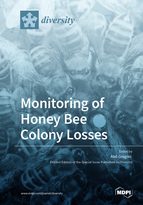Monitoring of Honey Bee Colony Losses
A special issue of Diversity (ISSN 1424-2818). This special issue belongs to the section "Animal Diversity".
Deadline for manuscript submissions: closed (31 January 2020) | Viewed by 72006
Special Issue Editor
Interests: honey bee; insect toxicology; cell biology; varroa; queen rearing; bee breeding
Special Issues, Collections and Topics in MDPI journals
Special Issue Information
Dear Colleagues,
Managed honey bees are subject to numerous internal and external pressures, including exposure to various pathogens, lack of diversity of food sources, and management problems. Bees are exposed to agrochemicals and a variety of stressors that act in isolation or, more often, in combination. Our understanding of the mechanisms, their interactions, and interpretation of factors that reduce honey bee vitality or even bee deaths needs intensive studies. The presenting biology of colony health and effected mechanisms caused by stress factors and their interactions are important objectives to be presented in this Special Issue of Diversity. Furthermore, the studies presented in this Special Issue of Diversity will be targeted at honey bees as individual or social organisms responding to a variety of pathogens causing American and European foulbroods, varroosis, mycosis, and other diseases. Factors such as environment stressors, honey bee colony management, and beekeeping practices also factor in colonies’ survival and the subject of a variety of studies and are welcomed for publication. Attention will be also given to the effects of pesticides on bees and their survival.
In this Diversity Special Issue entitled “Monitoring of Honey Bee Colony Losses", we encourage researchers to present new studies of nature, mechanisms, and relative importance of the potential factors in the recent losses in the beekeeping sector. The apparent lack of reliable and comparable experimental laboratory and field data on honey bee colony losses may encourage researchers to perform and publish new studies of the factors, their synergistic interactions, and mechanisms contributing to colony losses worldwide.
Prof. Aleš Gregorc
Guest Editor
Manuscript Submission Information
Manuscripts should be submitted online at www.mdpi.com by registering and logging in to this website. Once you are registered, click here to go to the submission form. Manuscripts can be submitted until the deadline. All submissions that pass pre-check are peer-reviewed. Accepted papers will be published continuously in the journal (as soon as accepted) and will be listed together on the special issue website. Research articles, review articles as well as short communications are invited. For planned papers, a title and short abstract (about 100 words) can be sent to the Editorial Office for announcement on this website.
Submitted manuscripts should not have been published previously, nor be under consideration for publication elsewhere (except conference proceedings papers). All manuscripts are thoroughly refereed through a single-blind peer-review process. A guide for authors and other relevant information for submission of manuscripts is available on the Instructions for Authors page. Diversity is an international peer-reviewed open access monthly journal published by MDPI.
Please visit the Instructions for Authors page before submitting a manuscript. The Article Processing Charge (APC) for publication in this open access journal is 2600 CHF (Swiss Francs). Submitted papers should be well formatted and use good English. Authors may use MDPI's English editing service prior to publication or during author revisions.
Keywords
- Honey bee diseases
- Stressors
- Pathology
- Honey bee mortalities
- Colonies management






